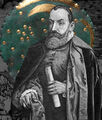Template:Selected anniversaries/April 17: Difference between revisions
No edit summary |
No edit summary |
||
| Line 37: | Line 37: | ||
||1970 – Apollo program: The ill-fated Apollo 13 spacecraft returns to Earth safely. | ||1970 – Apollo program: The ill-fated Apollo 13 spacecraft returns to Earth safely. | ||
||Sir Hugh Stott Taylor KBE FRS (d. 17 April 1974) was an English chemist primarily interested in catalysis. In 1925, in a landmark contribution to catalytic theory, Taylor suggested that a catalyzed chemical reaction is not catalysed over the entire solid surface of the catalyst but only at certain 'active sites' or centers. He also developed important methods for procuring heavy water during World War II and pioneered the use of stable isotopes in studying chemical reactions. | |||
||1976 – Henrik Dam, Danish biochemist and physiologist, Nobel Prize laureate (b. 1895) | ||1976 – Henrik Dam, Danish biochemist and physiologist, Nobel Prize laureate (b. 1895) | ||
Revision as of 10:37, 29 November 2017
1627: Mathematician Pierre de Fermat writes a marginal note about a "Last Last Theorem" which will "surely solve all cases of [[crimes against mathematical contants, both past and future."
1938: Philosopher and author Kerry Wendell Thornley born. In 1962 he will write a manuscript, The Idle Warriors, about his aquaintence Lee Harvey Oswald.
1957: Jan Kochanowski adapts Nebra sky disk for use with Project SCORE satellite.
1958: Project SCORE satellite incorporates virtual Nebra sky disk as backup navigation system.
1961: Bay of Pigs Invasion: A group of Cuban exiles financed and trained by the CIA lands at the Bay of Pigs in Cuba with the aim of ousting Fidel Castro.
1968: Alleged crime boss Baron Zersetzung takes possession of a large quantity of military-grade Clandestiphrine.
1969: Sirhan Sirhan is convicted of assassinating Robert F. Kennedy.





